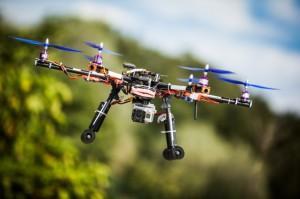by Emily Atkin / Climate Progress

Credit: Shutterstock
When thinking about the possible abilities of unmanned flying drones, the first thing that comes to mind is probably not benefits for the fossil fuel industry.
But in Scotland, that’s exactly what’s happening.
According to a report in BBC news, researchers at the University of Aberdeen have developed drones that can scan rock formations underneath the ocean — in some cases, in the deep sea. The drones will be able to locate the reserves, then estimate how much they can produce by comparing them to models of fuel-producing rock formations that occur above sea levels, University of Aberdeen geoscientist John Howell said.
The data collected by the drone is then used to make virtual maps of deep-sea rock formations that Howell says are accurate within less than a few millimeters.
“The advantage of the drone is that it allows us to collect large volumes of data from otherwise inaccessible cliff sections in remote and often dangerous places,” Howell said.
More than 20 oil companies have financed the research so far, the BBC reported, with each drone expected to cost more than $16,000 each. They are expected to be in full use by 2014.
This is not the first time, however, that drones have been eyed by the energy industry. The Federal Aviation Administration in July issued an approval that paved the way for a “major energy company” to fly unmanned drones in U.S. airspace.
In August, the company was revealed to be ConocoPhillips, one of the largest oil and gas exploration and production companies worldwide. Those drones were said to be used to survey ice floes and migrating whales while the company mounts oil exploration efforts.
ConocoPhillips said it also expects to use the drones for emergency response, oil spill monitoring, and wildlife surveillance. Other drones have been tested or talked about for use in pipeline and wellhead inspections in remote areas.

